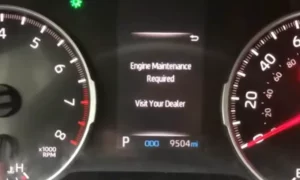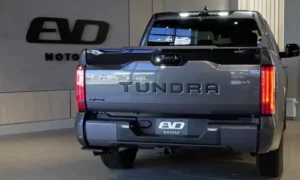You turn the key, press the button on your fob, and… nothing. Your Toyota Highlander’s rear hatch sits stubbornly closed (or worse, partially open). It’s frustrating, especially when you’re juggling groceries or trying to load up for a family trip. This guide walks you through every possible cause and solution, from quick fixes you can try right now to more complex repairs.
Common Reasons Your Toyota Highlander Rear Hatch Won’t Work
The Power Switch Is Turned Off
Many Highlander owners don’t realize there’s a dedicated power switch for the rear hatch. This small oversight is actually one of the most common culprits.
Look inside your glove compartment for a switch labeled “Power Back Door.” If it’s in the “Off” position, your power liftgate won’t respond to any commands. This feature exists as a safety measure but is easily toggled accidentally, especially in households with children who might explore the glove box.
To fix this, simply flip the switch to the “On” position and test your liftgate again. This simple check resolves many apparent malfunctions without any tools or technical expertise.
Blown Fuse Issues
A blown fuse can completely disable your power liftgate. Toyota Highlanders have specific fuses dedicated to the rear hatch operation.
To check the fuses:
- Locate the interior fuse box on the driver’s side dashboard
- Find the engine compartment fuse panel
- Look for fuses labeled “PBD” or “Back Door” (in 2014–2019 models, this is typically a 30A fuse)
- Inspect for any broken metal strips inside the fuse
If you find a blown fuse, replace it with a new one of identical amperage. Using the wrong amperage can damage electrical components or create fire hazards. Blown fuses often indicate underlying issues like voltage surges or short circuits in the liftgate wiring harness.
Key Fob Problems
Your key fob might be the issue if:
- The battery is weak or dead
- You’re standing too far from the vehicle (the fob needs to be within about 3 feet of the liftgate)
- The fob has internal damage
Try replacing the battery in your key fob—it’s an inexpensive fix that might solve your problem. Also, make sure you’re standing close enough to the vehicle when attempting to operate the liftgate.
Mechanical Failures That Stop Your Rear Hatch
Faulty Liftgate Struts
Liftgate struts are hydraulic cylinders that help support the weight of your hatch. When they fail, your hatch may:
- Stop halfway through opening
- Close unexpectedly
- Feel unusually heavy when manually operated
- Make grinding or clicking noises
The 2014–2019 Highlanders use electric struts particularly sensitive to temperature fluctuations. In colder climates, these struts often lose pressure and fail to function properly.
Replacing struts is a relatively straightforward DIY project:
- Purchase compatible replacement struts (aftermarket options like StrongArm 4400 or Stabilus Lift-O-Mat cost $50–$150 per pair)
- For electric struts, disconnect the battery before installation to prevent shorts
- Remove the old struts using basic hand tools
- Install the new struts, making sure they’re secured properly
A properly executed strut replacement can restore your liftgate’s smooth operation for years.
Hinge and Alignment Problems
Your liftgate hinges may be misaligned or damaged, preventing proper operation. Signs include:
- Visible gaps between the hatch and the vehicle body
- Grinding or scraping noises during operation
- Liftgate that won’t fully close or latch
The Toyota Highlander has faced documented issues with hinge fatigue, particularly with the driver-side hinge bowing under stress. This problem is serious enough that it’s mentioned in class action litigation against Toyota.
To address minor misalignment:
- Loosen the hinge bolts
- Adjust the liftgate position to eliminate gaps
- Retighten the bolts to secure the new alignment
- Apply lithium grease to the pivots to reduce wear
For severe hinge damage, professional repair or replacement may be necessary.
Electrical System Malfunctions
Battery and Voltage Problems
Your vehicle’s 12V battery provides the power needed for liftgate operation. A weak battery can cause intermittent failures or complete malfunction of your power liftgate.
Check your battery’s voltage with a multimeter—it should read between 12.4 and 12.7 volts when the engine is off. Lower readings suggest your battery needs charging or replacement. Also inspect the battery terminals for corrosion, which can prevent proper electrical flow.
Wiring Harness Damage
The wiring harness that connects your liftgate to the vehicle’s electrical system can develop issues:
- Broken wires from repeated opening/closing
- Water intrusion causing corrosion
- Physical damage from impacts
Look for any visible damage to the wires running to your liftgate. Pay special attention to the flexible section that bends each time the hatch opens. Damaged wiring often requires professional diagnosis and repair.
Software and Calibration Issues
Reset Needed for Liftgate Memory
Your Highlander’s power liftgate has a memory function that remembers how high to open. This calibration can be disrupted, causing the hatch to stop at incorrect heights or fail to open/close completely.
To recalibrate your liftgate:
- Manually open the hatch to your desired height
- Press and hold the liftgate button for 3-5 seconds until you hear a confirmation beep
- Close the hatch and test the automatic function
This process resets the positional memory and often resolves issues where the liftgate stops prematurely.
Vehicle Safety Overrides
Several safety features can prevent your liftgate from operating:
- An open rear window disables the liftgate system
- The transmission must be in Park
- The vehicle must be stationary
Ensure all these conditions are met before troubleshooting further. These safety overrides exist to prevent damage to the vehicle and potential injuries.
DIY Troubleshooting Checklist
Follow this step-by-step process to diagnose your Highlander’s rear hatch problems:
Step 1: Preliminary Checks
- Verify your key fob is working and within 3 feet of the liftgate
- Confirm the rear window is fully closed
- Check that the “Power Back Door” switch in the glove box is turned on
- Ensure the vehicle is in Park and stationary
Step 2: Electrical Diagnostics
- Inspect fuses in both the interior and engine compartment fuse boxes
- Check your 12V battery’s charge level and connection
- Listen for clicking sounds when activating the liftgate (indicates power is reaching the motor)
Step 3: Mechanical Inspection
- Examine liftgate struts for leaking fluid or damage
- Check for proper alignment and gaps around the closed hatch
- Look for obstructions in the latch mechanism
- Test manual operation to assess resistance levels
Toyota’s Known Issues and Legal Implications
Toyota Highlander liftgate problems aren’t isolated incidents. A class action lawsuit (Morgan & Morgan v. Toyota Motor North America) alleges Toyota concealed liftgate defects in multiple models, including several Highlander generations.
Key claims in the litigation include:
- Design flaws causing hinge failure, particularly on the driver’s side
- Problems typically appearing after the warranty period expires
- Repair costs ranging from $4,000–$5,000
- Toyota’s alleged failure to properly notify consumers of known issues
In 2012, Toyota issued a service bulletin (T-SB-0044-12) acknowledging hinge alignment issues but limited repairs to vehicles under warranty. This selective approach has fueled allegations of corporate negligence.
If you’ve experienced repeated liftgate failures, you may be eligible to join this class action to recover repair expenses. Document all repairs, save invoices, and consider filing a complaint with the National Highway Traffic Safety Administration (NHTSA).
Preventative Maintenance Tips
To avoid future rear hatch problems:
- Regular lubrication: Apply silicone-based lubricant to hinges and latches twice yearly
- Avoid forcing the liftgate: Let the power system do its job without manual interference
- Keep it clean: Prevent debris buildup around seals and latches
- Watch for early warning signs: Address unusual noises, slow operation, or alignment issues promptly
- Protect electrical components: Keep water away from exposed wiring and connections
Regular maintenance can extend the life of your liftgate components and help you avoid costly repairs down the road.
Professional Repair Options and Costs
When DIY solutions don’t work, professional repair may be necessary. Here’s what to expect:
| Repair Type | Typical Cost | Parts Required | Labor Hours |
|---|---|---|---|
| Fuse Replacement | $20-50 | Fuse kit | 0.5 |
| Strut Replacement | $250-400 | Two struts | 1-2 |
| Hinge Repair | $400-800 | Hinge assembly | 2-3 |
| Motor Replacement | $700-1,200 | Liftgate motor | 2-3 |
| Control Module | $800-1,500 | Module, programming | 2-4 |
| Complete Liftgate Assembly | $3,000-5,000 | Full assembly, hinges | 4-8 |
Costs vary significantly based on:
- Your vehicle’s model year
- Your location and labor rates
- Whether you use OEM or aftermarket parts
- If additional components need replacement
Always get multiple quotes from reputable repair shops, and ask if they’ve worked on Highlander liftgate issues specifically, as experience with these particular problems can lead to more efficient diagnosis and repair.
When Simple Fixes Aren’t Enough
If basic troubleshooting hasn’t resolved your issue, consider these options:
- Dealership diagnosis: Toyota service departments have specialized diagnostic equipment for complex electrical issues
- Independent Toyota specialists: Often more affordable than dealerships with similar expertise
- Extended warranty coverage: Check if your vehicle is still covered for this type of repair
- Technical service bulletins: Ask if any TSBs apply to your specific liftgate issue
- Class action participation: Document your repair history for potential reimbursement
Remember that complex electrical issues often require professional diagnostic equipment to pinpoint. Spending money on proper diagnosis can save you from replacing parts unnecessarily.
By following this comprehensive guide, you’ll be well-equipped to handle most Toyota Highlander rear hatch problems. From simple fixes like checking the power switch to more complex repairs, understanding the common failure points puts you in control of getting your liftgate working again.














